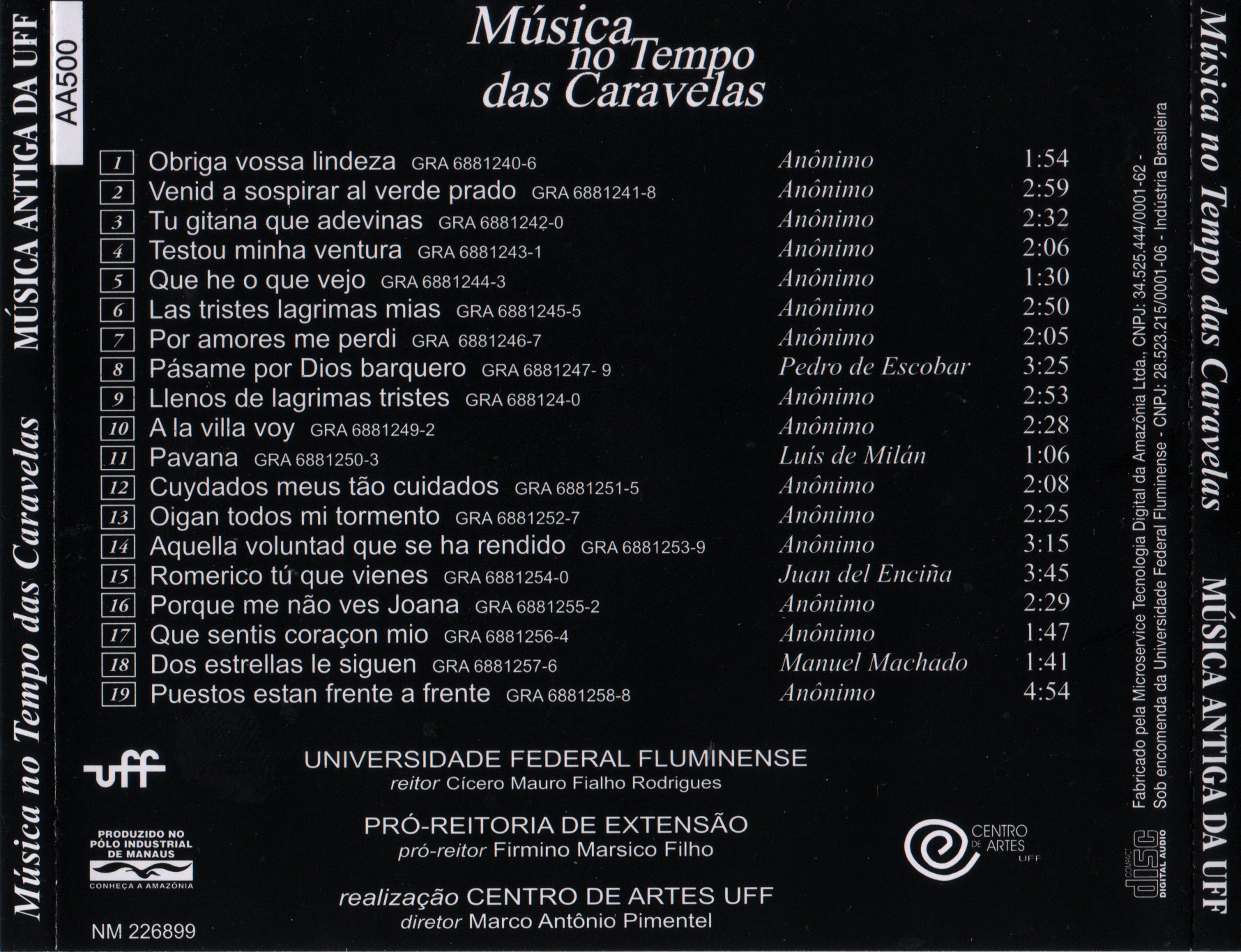Música no Tempo das Caravelas
Música Antiga da UFF
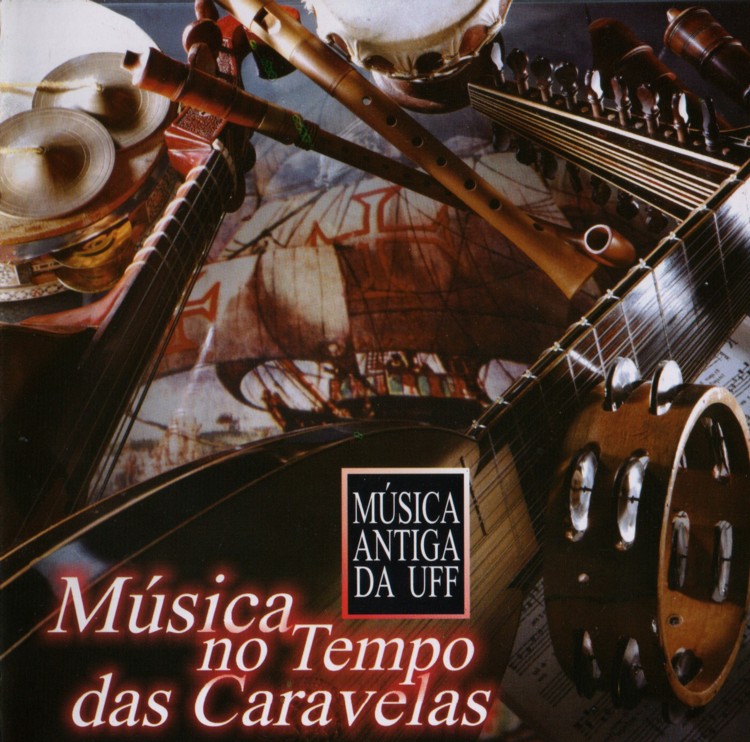
centrodeartes.uff.br |
discogs.com
UNIVERSIDADE FEDERAL FLUMINENSE
CENTRO DE ARTES UFF
AA 500 ·
NM 226899
1998
1. Obriga vossa lindeza [1:54]
2. Venid a sospirar al verde prado [2:59]
3. Tu gitana que adevinas [2:32]
4. Testou minha ventura [2:06]
5. Que he o que vejo [1:30]
6. Las tristes lagrimas mias [2:50]
7. Por amores me perdi [2:05]
8. Pásame por Dios barquero [3:25]
Pedro de ESCOBAR
9. Llenos de lágrimas tristes [2:53]
10. A la villa voy [2:28]
11. Pavana [1:06]
Luis de MILÁN
12. Cuydados meus tão cuidados [2:08]
13. Oigan todos mi tormento [2:25]
14. Aquella voluntad que se ha rendido [3:15]
15. Romerico tú que vienes [3:45]
Juan dell' ENCINA
16. Porque me não ves Joana [2:29]
17. Que sentis coraçon mio [1:47]
18. Dos estrellas le siguen [1:41]
Manuel MACHADO
19. Puestos estan frente a frente [4:54]
versos: Mighel Leitão d'Andrade
declamação: Virgínia van der Linden
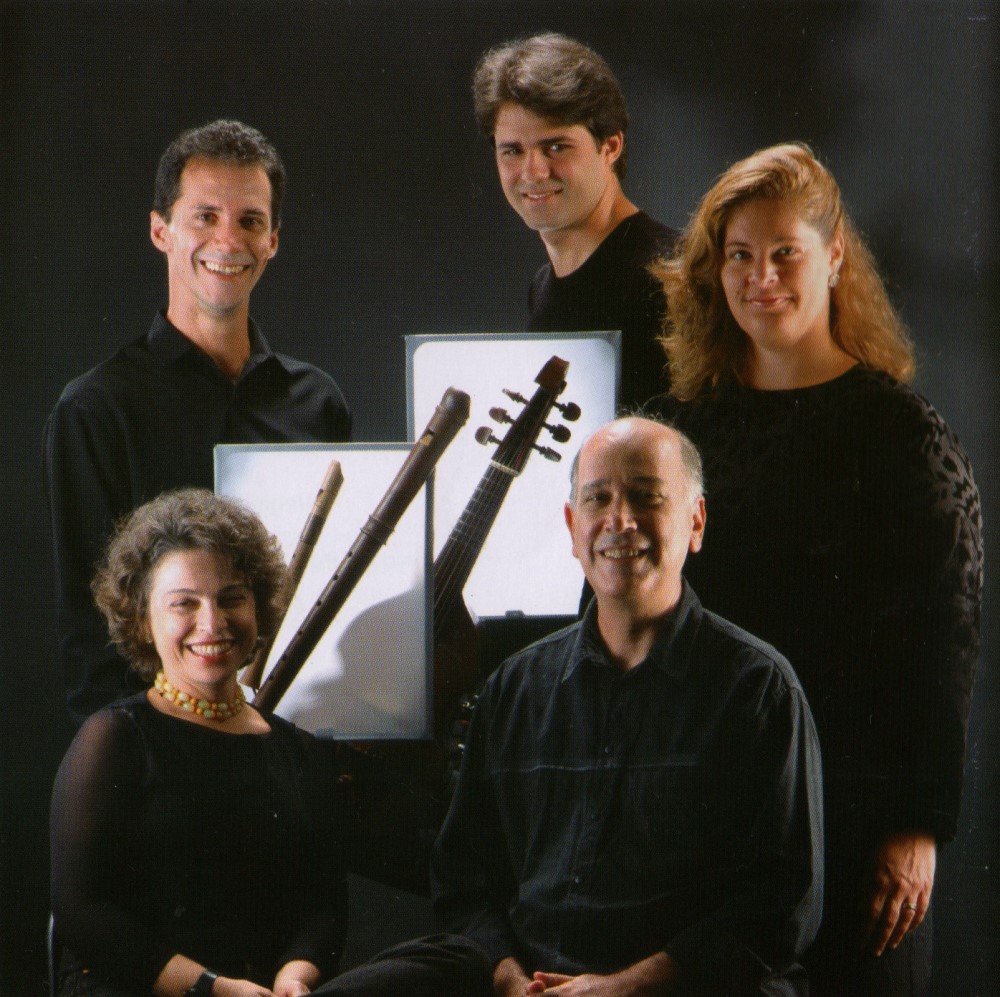
CONJUNTO MÚSICA ANTIGA DA UFF
Peri Santoro: barítono, flauta doce
Kristina Augustin: viola da gamba, percussão
Leandro Mendes: tenor, flauta doce, khrummhorn
Mário Orlando: viola da gamba, flauta doce, percussão, coro
Virgínia van der Linden: flauta transversa, flauta doce, khrummhorn, coro
ARTISTAS CONVIDADOS
Sônia Leal Wegenast: soprano, harpa e percussão
Nicolas de Souza Barros: alaúde, guitarra renascentista e guitarra barroca
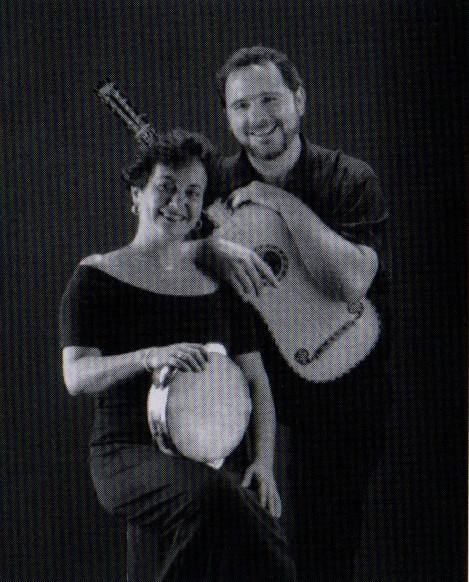
CANCIONEIRO MUSICAL D'ELVAS
Transcrição e estudo de Manuel Morais
Portugaliae Musica, Fundação Calouste Gulbenkian,1977, Lisboa.
FICHA TÉCNICA
produção musical e direção de estúdio: Wagner Campos
produção executiva: Virgínia van der Linden
técnico de gravação: Antônio de Pádua Barbosa (Tuninho)
masterização: Júlio Cesar Tôrres
projeto gráfico: Roberto Fanára
fotos: Humberto Medeiros
Gravado no 3D Estúdio em agosto de 1998.
Agradecimentos
Lúcia Meira e Paço Imperial, Helder Parente, Nicolas de Souza Barros,
Maria do Amparo Tavares Maleval, Marlene Pinto Mendes
e em especial a Luiz Pedro Antunes.
English liner notes

Música no Tempo das Caravelas
Música Ibérica à Época do Descobrimento
Em 1992 saudávamos com entusiasmo a gravação do LP intitulado Cantares de Amor, Suspiros e Cuydados,
que o Conjunto de Música Antiga da UFF, sob os auspícios
da FUNIARTE, realizara. Incluía-se, então, nas
comemorações dos 500 anos da conquista da América,
uma vez que as músicas selecionadas eram exemplos das que
animavam os serões palacianos em Portugal e Espanha, ao tempo
das descobertas ultramarinas.
Passados seis anos, quando se aproxima o ano 2.000 e já se
iniciam as festas comemorativas dos 500 anos da conquista do Brasil
pelos portugueses, esse meritório Conjunto retoma as
músicas do citado LP, acrescenta-lhes outras, e oferta-nos um
ainda mais rico documento cultural da Era da Expansão
ibérica.
Sobre as letras do Cancioneiro de Elvas (Biblioteca Públia Hortênsia)
À exceção das composições Dos estrellas le siguen e Puestos estan frente a frente, bem como do solo de alaúde, todas as demais peças que compõem este CD foram retiradas do Cancioneiro da Biblioteca Públia Hortênsia,
de Elvas (Portugal), se bem que para a composição
"Romerico, tú que vienes" optou-se pela
transcrição da letra, mais completa, do Cancionero Musical de Palacio.
É raríssimo o "Cancioneirinho de mão", pequeno
volume manuscrito sobre papel de 14,5 cm X 10 cm, possivelmente
quinhentista, encontrado em 1928 na referida biblioteca de Elvas pelo
musicólogo Manuel Joaquim, que o publicaria em Coimbra, no ano
de 1940. A encadernação, evidentemente que posterior
à sua elaboração, como observara o
pesquisador-editor, dava a obra como pertença de um
enigmático J. J. d' A., ao que tudo indica iniciais de
João Joaquim de Andrade, retratado em quadro também
pertencente à Biblioteca. Curioso para nós, brasileiros,
é que muito possivelmente o precioso Cancioneiro
fora adquirido no Brasil, quem sabe para cá trazido pela Corte
Real portuguesa em 1808, uma vez que o eclesiástico seu
possuidor vivera por algum tempo no Rio de Janeiro, segundo legenda
apensa ao seu retrato.
Quanto ao conteúdo, compõe-se de duas partes. Na
primeira, encontram-se 65 composições com letra e
notações musicais, que indicam serem elas a três
vozes. Na segunda, 36 poesias sem música. Em todo o conjunto,
predominam as letras em castelhano, sendo que apenas 19 foram grafadas
em português.
Várias marcas levam os especialistas a reconhecer como dos
séculos XV e XVI as suas composições. Já
Manuel Joaquim observara que uma delas seria a similaridade de certos
desenhos que o papel utilizado apresenta em relação a
papéis fabricados no século XVI, remontando os mais
semelhantes à Salzburgo de 1525. Outra, seria a recolha, na
coletânea, de música de Juan del Encina — tal seja,
a composição Romerico tu que vienes. E, ainda, a analogia das letras com poemas do Cancioneiro Geral de Garcia de Resende.
Este, fora publicado em 1516, constituindo uma recolha da
produção poética dos reinados de Afonso V, D.
João II e D. Manuel. Tal analogia se mostra tanto na forma
quanto na temática dos textos, bem como na marcante
presença da língua e da cultura castelhana que neles se
percebe — de resto uma tônica da época, devido a
implicações políticas relacionadas com a
aspiração dos soberanos, de unirem as coroas
luso-espanholas, através de guerras e casamentos.
A tendência dominante nessas letras-poemas, quanto à
forma, é para os versos curtos, de arte-menor, principalmente
redondilhos, sendo reduzidíssima a ocorrência dos versos
mais longos, de arte-maior. Abandonando a tradição
paralelística trovadoresca, e pautando-se pela mentalidade
glosadora então dominante na prédica clerical e no ensino
universitário, bem como no folclore espanhol, elegeram os
poetas-letristas de então como estrutura mais usual dos seus
poemas a glosa, volta ou desenvolvimento de um mote. Daí que as formas estróficas mais utilizadas sejam as do vilancete, da cantiga e suas variações. Ao lado dessas, encontravam-se também os romances (poemas narrativos) e as esparsas
(composições monostróficas, de versos mais
longos). E destacava-se, no que concerne às
caracterísiticas retóricas, o virtuosismo dos jogos
verbais, tantas vezes instaurando o paradoxo.
Quanto à temática, amorosa, a recorrência mais comum é a do cuidar (isto é, sofrer em segredo a dor da paixão), do suspirar (extravasando a emoção), do morrer de amor (na esteira das cantigas de amor galego-portuguesas e das canções provençais), e dos olhos/olhar
como fonte ou repositório do sentimento amoroso. Não
raras vezes esses temas aparecem unidos numa mesma
composição.
Assim, com relação ao tema dos olhos, ou do olhar/ver e apaixonar-se, na cantiga
"Que é o que vejo", o mote joga com os sentidos de ver/perceber e de ver (a senhora) como causa do "morrer d'amor e desejo"; mas as glosas afirmam que, se a esquivança da dama provoca sofrimento, não vê-la provocaria a morte. No vilancete
"Por que não me vês, Joana" demonstra-se como a
distância do olhar aumenta o desejo pela mulher querida. Em "Dos
estrellas le siguen" (aliás, a única a quatro vozes do
repertório, até por não pertencer ao Cancioneiro de Elvas),
os olhos feiticeiros (da morena) são metaforizados em estrelas
que dão luz ao próprio sol. No terceto em arte-maior
"Aquella voluntad", representa-se novamente o poder encantatório
dos "ojos", que subjugam com seu "puro resplandor". Na cantiga
"Obriga vossa lindeza", retoma-se mais uma vez o tema do ver (a beleza
da Dama) e apaixonar-se, unido ao do paradoxal viver/morrer de amor. E
no mote "Llenos de lagrimas
tristes", os olhos aparecem dando vazão aos sentimentos
através das lágrimas, unindo-se, dessa forma, ao
tema do suspirar.
Quanto às demais peças, vemos que na cantiga "A la villa voy" o sujeito da poesia atribui à dor de amor a angústia que o atormenta. No vilancete
"Por amores me perdi", compara-se a perdição
perdição amorosa à muito pior por falta de amor.
Em "Pásame por Dios barquero", anseia o apaixonado por um
lugar onde poderia descansar dos seus tormentos. Na
composição em arte-maior "Venid a sospirar", retoma-se a
temática do morrer de amor, já numa atmosfera evocativa do clássico locus amoenus, seus verdes prados e pastores. No vilancete
"Oigan todos", percebe-se claramente a temática do suspirar,
ligada à preocupação com o receptor do desabafo
apaixonado. Também em "Romerico tu que vienes" esse é o
tema, já que o amante fala da sua dor de amor ao romeiro, a quem
pede notícias da amada; acontece, então um diálogo
entre ambos, o que coloca dita composição, em sua
versão mais completa, na esteira das tenções do
Trovadorismo medieval, ou ainda das suas cantigas de amigo,
embora convertendo em masculino o desabafo feminino que a estas
caracterizava. Em "Tu gitana que adeviñas", o apaixonado busca,
nos poderes clarividentes de uma cigana, saber quando morrerá,
já que termina por não ver saída para a sua dor. E
no vilancete "Cuydados meus tão cuidados", é estabelecida pelo apaixonado uma reflexão sobre o cuidar, que o leva ao descuidar de si.
Enquanto o amor era cantado desta forma na amenidade dos serões
palacianos, as árduas e mesmo violentas conquistas
marítimas se efetuavam, para mais tarde serem genialmente
louvadas por Camões, ou satirizadas por Fernão Mendes
Pinto. E como Manuel Joaquim, no Prólogo da sua
edição do Cancioneiro Poético e Musical da Biblioteca Públia Hortênsia,
só poderíamos desejar, em relação às
peças musicais por ele descobertas, "que os nossos artistas
tomem a peito dar-lhes vida com seu talento".
É o que novamente faz o Música Antiga da UFF,
pelo que merece os nossos aplausos e a nossa gratidão.
Não se limitando a essas peças da época
áurea de Portugal, documentam também, no romance
"Puestos están frente a frente", o seu ocaso: trata-se da
narrativa da batalha de Alcácer-Quibir, em 1578, na qual o jovem
rei português, D. Sebastião, desapareceria, sem deixar
herdeiros para a coroa, que, com a morte do seu tio-avô, o
Cardeal D. Henrique, em 1580, passaria para o domínio de
Espanha, do qual só se libertaria em 1640, sem jamais retomar o
brilho perdido. Brilho este que, no entanto, a arte perenizou, e que
ora se representa nas peças deste CD, pelo que se torna
valiosíssimo às comemorações do quinto
centenário da conquista do Brasil.
Maria do Amparo Tavares Maleval
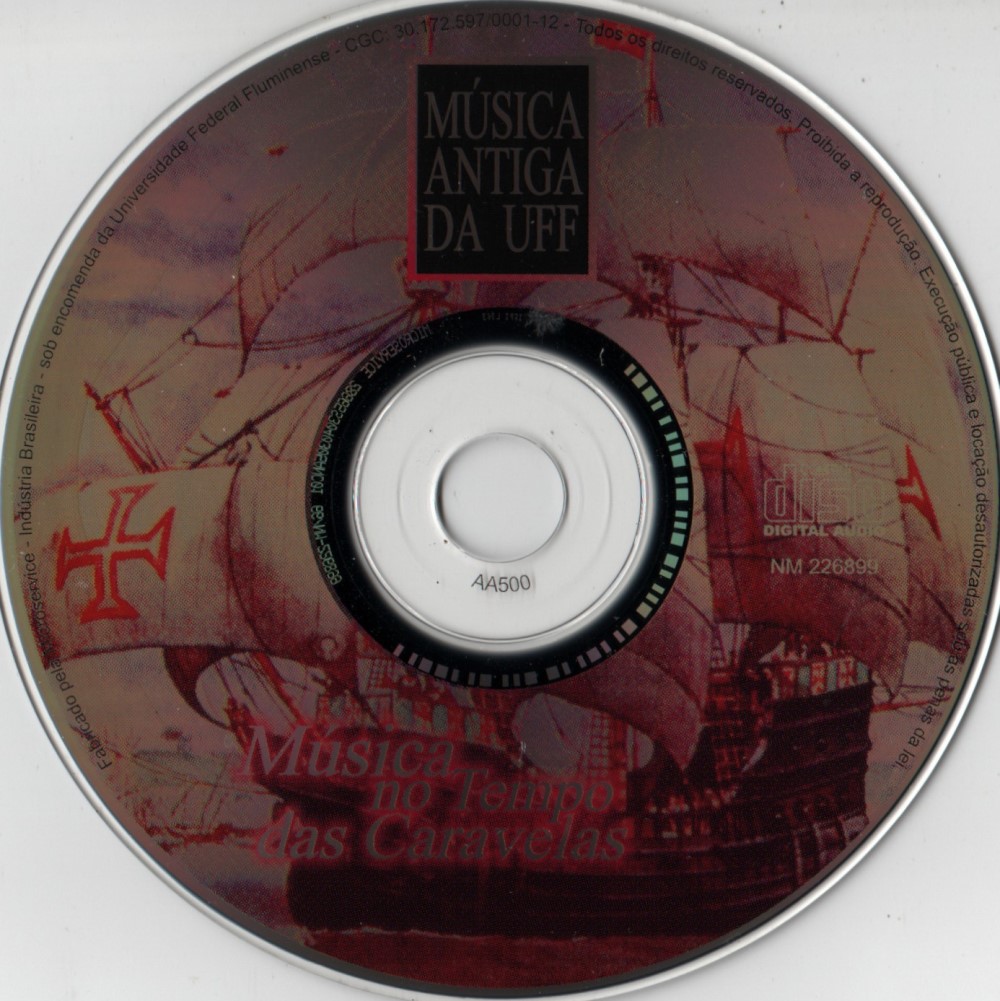
The release of the recording "Cantares de Amor, Suspiros e Cuydados"
(Songs of love, sighs and worries) in 1992, by the Early Music Ensemble
of the Fluminense Federal University (UFF), based in Niterói,
(state of Rio de Janeiro), was enthusiastically received by music
lovers and critics. This LP was included in festivities celebrating the
500th anniversary of the Discovery of the New World, as certain songs
within it are from that historical period, and would probably have been
included in chamber concerts held at the royal houses of Spain and
Portugal.
Six years have gone by, and events commemorating the 500th anniversary
of Brazil's discovery by the Portuguese (in 1500) are already being
organized. In celebration of this historic occasion, the UFF Early
Music Ensemble have recorded a CD, which focuses more closely on music
from the time of the Iberian Expansion, and includes some of the songs
present in the 1992 LP, in order to present us with an even richer
cultural portrait of the period.
About the Cancioneiro de Elvas Lyrics (Públia Hortênsia Library)
With the exception of the songs "Dos estrellas le siguen" and "Puestos
estan frente a frente", as well as the lute solo, all the other pieces
included in this CD were taken from the "Cancioneiro da Biblioteca
Públia Hortênsia", found in the Portuguese city of Elvas.
In the specific case of the song "Romerico, tu que vienes", the lyrics
used were transcribed from an alternative version of the same work,
which were more complete, found in the "Cancioneiro Musical do Palacio"
This small manuscript volume (Hortênsia), with the title
"Cancioneirinho de mão", is very rare, and probably dates from
the XVIth century. It was found in 1928 in the Library of Elvas by the
Portuguese musicologist Manuel Joaquim, who published it in Coimbra
(Portugal) in 1940. On its cover, which evidently is posterior to the
XVIth century (according to M. Joaquim), we also see an enigmatic
inscription - "J.J. d' A", which most probably were the initials of
João Joaquim de Andrade, whose portrait can also be found in
this library. Of particular interest to Brazilians is the possibility
that this precious songbook may have been acquired in Brazil, perhaps
having been brought to our country by the Portuguese Royal Family in
1808, as its owner lived for some time in Rio de Janeiro, according to
a small text appended to his portrait.
The songbook's contents can naturally be divided into two sections: in
the first we find 65 three-part compositions, with accompanying lyrics;
in the second, 36 poems without music. On the whole, lyrics in Spanish
(Castilian) predominate, as only 19 of the 65 songs use Portuguese.
Several clues lead specialists to identify this material as belonging
to the XVth and XVIth centuries. Manuel Joaquim observed that one of
these is the similarity of certain patterns found on the paper used in
the songbook with those on paper manufactured in the XVIth century,
most particularly in Salzburg (Austria), in 1525. Another clue is the
presence within the songbook of a song by Juan del Encina: "Romerico,
tu que vienes". Yet another is the similarity of certain lyrics with
poems found in the "Cancioneiro Geral de Garcia de Resende". This
songbook, published in 1516, consists of poetry produced in the reigns
of Afonso V, João II and D. Manuel. This resemblance can also be
perceived both in the forms used as well as the themes of the texts,
and, in the potent presence of Castilian language and culture - a
constant of the period, due to political aspirations of monarchs
pertaining to the unification of the Portuguese and Spanish crowns,
whether by way of war or wedding.
The dominant tendency of these poems, with regard to their structure,
is the use of small verses, particularly "redondilhos". Abandoning the
troubadour forms (which were longer), the poets of the period chose as
their preferred models the "glosa", the "volta" and the development of
the "mote", for which reason strophic forms more usually employed are
the "vilancete", the "cantiga" and their variations. We also find
"romances" (narrative poems) and "esparsas" (monostrophic compositions
with longer verses). With relation to rhetorical characteristics,
special interest is to be found in word-games within the material,
often leading to paradoxes.
Regarding the thematic content, mainly amourous, the most common
elements are the "cuidar" (worry or anguish - the suffering that ensues
from unrequited love), the "suspirar" (sighing - where this emotion is
vented), the "morrer de amor" (literally dying from love, following
models found in the "cantigas de amor" of Galician-Portuguese origin as
well as in the Provençal songs) and the "olhos/olhar" (eyes and
the act of looking) as the source of or place where emotion resides.
Very often we can identify more than one of these themes in the same
song.
Thus, in relation to the eyes theme, or the "looking and falling in
love", we will find in the "cantiga" "Que é o que vejo", that
the "mote" deals with the play on words of seeing-perceiving, and the
"perceiving " of the lady as cause of "dying from love and desire";
however the "glosas" make clear that, if looking at the lady provokes
suffering, not being able to would lead to death. In the "vilancete"
"Por que me nao ves, Joana", it is demonstrated that the greater the
distance from which the loved one is seen, the greater the desire for
her. In "Dos estrellas le siguen" (the only four-part song), the
enchanting eyes of the (brunette) lady (morena) become stars that
illuminate the sun. In "Aquella voluntad", the power of eyes is again
emphasized, as these subdue with their "pure splendor". In the
"cantiga" "Obriga vossa lindeza", once more we are reminded of the
connection between seeing (the beauty of the Lady) and falling in love,
as well as the apparent paradox of "living and dying for love".
Finally, in the "mote" "Llenos de lagrimas tristes", the eyes express
emotion through tears, uniting this theme with that of "sighing".
As to the other songs, we see in the "cantiga" "A la villa voy", the
perception of the narrator that the source of his anguish is that he
has fallen in love. In the "vilancete" "Por amores me perdi", the
comparison is made between the pain of being in love with the much
greater pain of not being in love. In "Pasame por Dios barquero", the
one in love yearns for a place where he can find release from his
torment. In "Venid a sospirar", we return to the theme of "dying for
love", in an evocative atmosphere of shepherds and meadows. The
"vilancete" "Oigan todos" clearly suggests the theme of "sighing",
together with the preoccupation of the narrator that the loved one is
hearing his anguished cry. In "Romerico to que vienes", this is also
the theme, as the lover speaks of his pain to the pilgrim, and asks for
news of his sweetheart - this leads to a dialogue between the two, and
places this work, in its fuller version, in the tradition of troubadour
forms of the medieval period or the "cantiga de amigo". In "Tu gitana
que adeviñas", the lover seeks, through the clairvoyant offices
of a gypsy, to find out when he will die, as he sees no way out of his
suffering. And in the "vilancete" "Cuydados meus tao cuidados", the
lover reflects on the nature of "worrying", which leads him not to
worry about himself.
While the theme of love is being sung about in the Iberian palaces,
arduous and oftentimes violent conquests are occuring on the oceans, to
be later eulogized by Cameies or satirized by Fernao Mendes Pinto. And
like Manuel Joaquim, in the Prologue of his edition of the "Cancioneiro
Poetico e Musical da Bibliotecalia Hortensia", we can only wish that,
in relation to the compositions which he discovered, that "our artists
have the courage to make these alive through their talent".
This is what the UFF Early Music Ensemble again achieve, for which they
deserve our gratitude and applause. Not limiting themselves to the
golden age of Portugal, they also document, through the "romance"
"Puestos estan frente a frente", its twilight: this is the story of the
battle of Alcacer-Quibir, in 1578, where the young Portuguese monarch,
D. Sebastião, disappeared, leaving no heirs to the throne,
which, upon the death of his grand-uncle, the Cardinal D. Henrique, in
1580, would go to Spain. On the return of a Portuguese monarch, in
1640, the golden age was lost forever. However, the luster of this
period is eternalized through art, particularly in the pieces contained
within this recording, which is exceptionally significant in relation
to the celebration of the 500th anniversary of the Portuguese Conquest
of Brazil.
Tradução: Marlene Pinto Mendes
Revisão: Nicolas de Souza Barros
